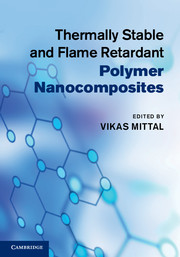Book contents
- Frontmatter
- Contents
- Contributors
- Preface
- Part I Thermal stability
- Part II Flame retardancy
- 7 Introduction to flame retardancy of polymer–clay nanocomposites
- 8 Flame retardant nanocomposites with polymer blends
- 9 Flame retardancy of polyamide/clay nanocomposites
- 10 Self-extinguishing polymer–clay nanocomposites
- 11 Flame retardant polymer nanocomposites with fullerenes as filler
- 12 Flame retardant polymer nanocomposites with alumina as filler
- 13 Polymer/layered double hydroxide flame retardant nanocomposites
- 14 Flame retardant SBS–clay nanocomposites
- Index
- References
10 - Self-extinguishing polymer–clay nanocomposites
from Part II - Flame retardancy
Published online by Cambridge University Press: 05 August 2011
- Frontmatter
- Contents
- Contributors
- Preface
- Part I Thermal stability
- Part II Flame retardancy
- 7 Introduction to flame retardancy of polymer–clay nanocomposites
- 8 Flame retardant nanocomposites with polymer blends
- 9 Flame retardancy of polyamide/clay nanocomposites
- 10 Self-extinguishing polymer–clay nanocomposites
- 11 Flame retardant polymer nanocomposites with fullerenes as filler
- 12 Flame retardant polymer nanocomposites with alumina as filler
- 13 Polymer/layered double hydroxide flame retardant nanocomposites
- 14 Flame retardant SBS–clay nanocomposites
- Index
- References
Summary
Introduction
Thermodynamically, the introduction of a solid particle into a polymer matrix either decreases or increases the interfacial energy, depending on the degree of interaction between polymer chains and solid surfaces. If strong absorption of the polymer chains on the surfaces takes place, the system can be approached through minimization of the interfacial energy, reducing the energy factors. Furthermore, the minimization of interfacial energy can be optimized by increasing the interfacial area of solid particles. Therefore, in order to maximize reduction of the interfacial energy, the solid particles need a large aspect ratio, making both layered silicates and carbon nanotubes (CNTs) good candidates. In particular, layered silicates cation-exchanged with organophilic surfactants can be delaminated into a single silicate sheet in a polymer matrix and remain as nanosheets with aspect ratio 100–1000. Because of this unique delamination of organophilic silicates, polymer–organoclay nanocomposites are of great interest in industry and academia. Numerous research groups have characterized and predicted the microstructures of polymer/organoclay nanocomposites using advanced techniques.
- Type
- Chapter
- Information
- Thermally Stable and Flame Retardant Polymer Nanocomposites , pp. 237 - 275Publisher: Cambridge University PressPrint publication year: 2011

